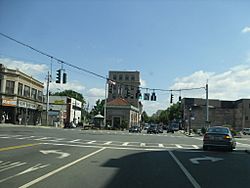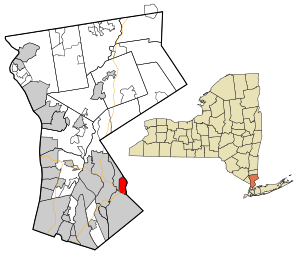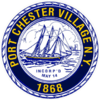Port Chester, New York facts for kids
Quick facts for kids
Port Chester, New York
|
||
|---|---|---|
| Incorporated Village of Port Chester | ||

Downtown Port Chester
|
||
|
||
| Nickname(s):
Gateway To New England
|
||
| Motto(s):
"Rich History, Great Future"
|
||

Location in Westchester County, New York
|
||
| Country | United States | |
| State | New York | |
| County | Westchester | |
| Town | Rye | |
| Area | ||
| • Total | 2.40 sq mi (6.22 km2) | |
| • Land | 2.33 sq mi (6.03 km2) | |
| • Water | 0.07 sq mi (0.19 km2) | |
| Elevation | 43 ft (13 m) | |
| Population
(2020)
|
||
| • Total | 31,693 | |
| • Density | 13,613.83/sq mi (5,255.96/km2) | |
| Demonym(s) | Port Chesterian | |
| Time zone | UTC-5 (Eastern (EST)) | |
| • Summer (DST) | UTC-4 (EDT) | |
| ZIP code |
10573
|
|
| Area code(s) | 914 | |
| FIPS code | 36-59223 | |
| GNIS feature ID | 0977392 | |
Port Chester is a village in New York. It is the largest part of the town of Rye in Westchester County. In 2020, about 31,693 people lived there.
Port Chester is part of the New York metropolitan area. It is close to Connecticut and the town of Greenwich. It is known as the "Gateway to New England." This means it's an important travel spot between New England states and New York. Its economy relies on small businesses, local government, and some big chain stores.
Contents
The Name of Port Chester
The Wappinger people first lived on this land. They called it "Haseco," which means "marshy land." When settlers came, the area was called Saw Pit. This name came from the saw pits used to cut logs for building homes. The name Saw Pit was first used in 1732. The village grew, and in 1868, it became Port Chester.
History of Port Chester
In 1660, three settlers bought land from the Native Americans. This land was near the Byram River. It became the lower part of what is now the town of Rye. Over the next ten years, more land was bought from Native Americans.
The Native Americans who signed these land deals had names like Shawanórõckquot and Cockho. Shanarocke was their leader, or "sachem." He was a Wiechquaeskeck Native American. The Wiechquaeskeck people lived in areas from Pelham to the Byram River.
The Saw Pit area was mostly quiet until the American Revolutionary War. A few farms and taverns were there. In 1683, the King of England gave this land to the Duke of York. This created the New York Colony. In 1788, New York decided that Saw Pit was part of the town of Rye.
Early roads in the area came from Native American trails. The Boston Post Road and King Street were important travel paths. Water travel was also key for growth. The Byram River and Long Island Sound helped the area develop. Early residents farmed and fished. After the Revolution, shipbuilding became important. The Lyon family built many ships there. By 1868, Port Chester was a major seaport.
The Byram River provided a good harbor. This helped Port Chester become an industrial center in the 1800s. When the railroad arrived in 1849, Port Chester grew even more. It became a place for factories and a getaway for wealthy New York City families. They built hotels, theaters, and large homes. Many immigrants from Germany, Ireland, and Italy came to Port Chester. They helped the village grow and become successful.
Steamships traveled from Port Chester to New York City from 1870 until World War I. Public services grew in the late 1800s. Roads were improved in the 1920s. Over 5,000 men from Port Chester served in World War I and World War II. After World War II, many companies set up offices or factories in Port Chester. For example, Life Savers had a factory there. This factory is now an apartment building. This shows how Port Chester changed from an industrial town to a residential area.
In 1974, a nightclub fire happened in Port Chester. It was a very sad event. This fire made people realize how important fire safety rules are. Today, fire safety is a top concern in Port Chester.
In recent years, Port Chester has worked on new development projects. The Port Chester Historical Society helps people learn about the village's past.
Geography and Climate
Port Chester covers about 2.4 square miles. Most of this is land, with a small part being water.
Port Chester has a humid subtropical climate. This means it has warm, humid summers and cool winters. Because it is near the coast, temperatures are not too extreme. It gets a good amount of rain and snow throughout the year. The average snowfall is about 29.8 inches per year. Summers are warm, but the sea keeps them cooler than inland towns.
Population and People
Port Chester has a diverse population. In 2019, about 30.6% of people were non-Hispanic white. About 63.9% were Hispanic or Latin American. Many people in Port Chester are from Mexico, Guatemala, Ecuador, Peru, Dominican Republic, and Colombia.
In 2010, there were 28,967 people living in the village. About 33.9% of homes had children under 18. The average household had about 3 people. The median age was 34.4 years old.
In 2019, the average income for a household in Port Chester was $74,920. Port Chester has a working-class population. Many people in Port Chester are Christian, especially Roman Catholic. Other religions like Judaism and Islam are also present.
Economy and Businesses
The Life Savers Candy Company had a factory in Port Chester from 1920 to 1984. This factory building is now apartments and is a famous landmark. National Collector's Mint was also based in Port Chester.
Some businesses in Port Chester include:
- American Automotive Equipment (since 1969)
Education
Port Chester has its own public school district. It is called the Port Chester-Rye Union Free School District. It was started in 1884, making it the oldest school district in Westchester County. Two schools in Port Chester are Port Chester Middle School and Port Chester High School.
The Japanese Weekend School of New York also holds classes at Port Chester Middle School. This school helps Japanese citizens and Japanese Americans learn about their culture.
Arts and Culture
The Port Chester-Rye Brook Public Library serves both Port Chester and Rye Brook. It was founded in 1876. The library has been updated several times. The latest renovation in 2012 added a teen room and a meeting room. It also made the children's room better. The library offers many programs, including reading activities for kids.
Another important cultural spot is the Capitol Theatre. This is a famous music venue. Many well-known artists have played there, like The Grateful Dead, Janis Joplin, and The Rolling Stones. Jerry Garcia of The Grateful Dead loved the theater. He said it was one of the best places for music. Because of this, parts of Port Chester have Grateful Dead decorations. Janis Joplin even wrote her song "Mercedes Benz" outside the Capitol Theatre.
Parks and Recreation
Port Chester has several parks for everyone to enjoy. They cover almost 50 acres.
- Abendroth Park: This park is 10.1 acres and has a special area for dogs.
- Columbus Park: This 9.4-acre park has basketball and volleyball courts. It also has playgrounds, a picnic area, and a water spray playground in summer. There is a soccer field too.
- Crawford Park: This park is owned by the town of Rye. It is used for soccer, T-ball, and softball.
- Edgewood Park: This 3.2-acre park has a youth baseball field and a small playground.
- Joseph Curtis Recreation Park: This 7.5-acre park has a playground, a baseball field, and a roller-skating rink.
- Lyon Park: This 20.3-acre park has two Little League fields and a playground. It is also home to the historic Bush-Lyon Homestead.
Several historic buildings in Port Chester are listed on the National Register of Historic Places. These include the Bush-Lyon Homestead, Capitol Theater, Life Savers Building, and St. Peter's Episcopal Church.
Transportation
Port Chester has good transportation options.
- The Bee-Line Bus System offers bus service on routes 13 and 61.
- Connecticut Transit Stamford also provides bus service on routes 311 and 311B.
- The Metro-North Railroad has a station in Port Chester. It is on the New Haven Line. You can take a train from here to Grand Central Terminal in New York City. You can also go to Stamford Transportation Center and New Haven-Union Station in Connecticut.
Notable People
Many interesting people have connections to Port Chester:
- PC Chris – A professional Super Smash Bros. Melee player.
- John Abercrombie – A jazz guitarist.
- Lex Barker – An actor famous for playing Tarzan.
- Herman Barron – A professional golfer.
- Keter Betts – A jazz double bass player.
- Edson Buddle – A Major League Soccer player.
- William W. Cook – A legal scholar.
- Luigi Del Bianco – The chief carver of Mount Rushmore.
- Arnold Diaz – A journalist.
- Aaron Sabato – A professional baseball player.
- Meaghan Francella – An LPGA golf player.
- George Gallo – A screenwriter and filmmaker.
- Adam Haslett – A writer.
- E.L. Konigsburg – A famous author and illustrator.
- Frank E. "Lank" Leonard – A cartoonist.
- Val Lewton – A writer and producer.
- Barry Lopez – A writer.
- D. J. MacHale – An American writer and director.
- Terrence McNally – A playwright.
- Brian Moran – A professional baseball player.
- Colin Moran – A professional baseball player.
- Andy Newmark – A rock and funk drummer.
- Richard Ogilvie – A former Governor of Illinois.
- Frank Pavone – A Roman Catholic priest.
- Ruth Roberts – A songwriter.
- Rachael Sage – A singer-songwriter.
- Pierre da Silva – A soccer player.
- Ed Sullivan – A famous entertainer.
- Art Tomassetti – A record-setting test pilot.
- David Tutera – A celebrity wedding planner.
- Anthony Vincent – A YouTuber and musician.
- Peter J. Vita – Holds a world record for the longest career as a barber.
Sister Cities
Port Chester is connected with other towns around the world:
See also
 In Spanish: Port Chester para niños
In Spanish: Port Chester para niños


